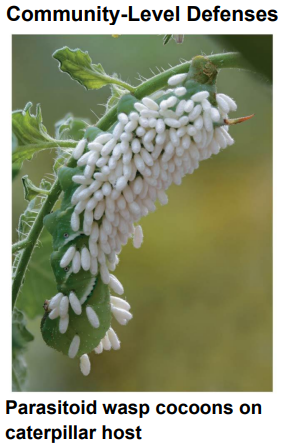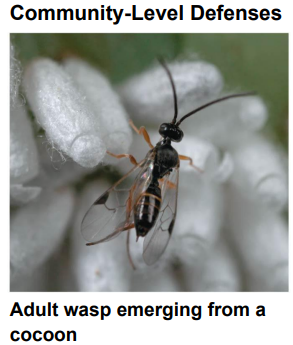39 | Plant Signals and Behaviors
Stimuli and a Stationary Life
(True) - Plants receive signals from the environment and respond by altering growth and development. Example: A dodder seedling bends toward the host plant due to the chemicals it releases.
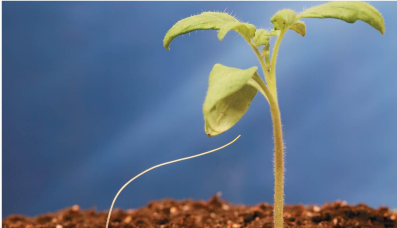
Concept 39.1: Signal Transduction Pathways Link Signal Reception to Response
Etiolation - It comprises of morphological adaptations for growing in darkness. A potato growing in the dark produces pale stems, unexpanded leaves, and short roots.
De-Etiolation - In involves changes leading to normal growth of shoots and roots after an etiolated plant is exposed to light.
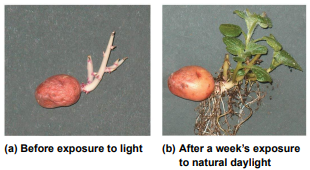
(True) - A potato’s response to light is an example of cell signal processing.
Reception, Transduction, Response - What are the three stages of cell signal processing?
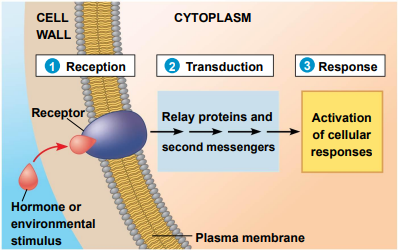
Reception
Receptors - These are proteins that detect signals. They change shape in response to specific stimuli.
Phytochrome - A receptor in de-etiolation, capable of detecting light.
Transduction
Second Messengers - They are responsible for transferring and amplifying signals from receptors to proteins that cause responses.
Calcium Ions (Ca2+), Cyclic GMP (cGMP) - What are the two types of second messengers, that play an important role in de-etiolation
(True) - The phytochrome receptor responds to light by opening Ca2+ channels, increasing Ca2+ levels in the cytosol. It also activates an enzyme that produces cGMP.
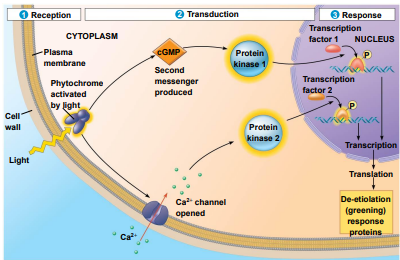
Response
(True) - A signal transduction pathway leads to regulation of one or more cellular activities.
(True) - In most cases, responses to stimulation involve increased enzyme activity.
Post-Translational Modification of Preexisting Proteins
(True) - Post-translational modification involves modification of existing proteins in the signal response.
(True) - Modification often involves phosphorylation of specific amino acids.
(True) - Second messengers, Ca2+ and cGMP, activate protein kinases directly.
Protein Kinases - These are kinases that selectively modifies proteins by covalently adding phosphates to them.
(True) - Protein kinases often work in a cascade, linking initial stimuli to gene expression.
Protein Phosphatases - It is an enzyme that removes a phosphate group from proteins. They “switch off” the signal transduction pathways by dephosphorylation of proteins.
Transcriptional Regulation
(True) - Transcription factors bind directly to particular DNA regions, controlling the transcription of specific genes.
(True) - Other transcription factors are repressors that decrease the transcription of specific genes.
De-Etiolation (“Greening”) Proteins
(True) - De-etiolation activates enzymes that: 1.) function directly in photosynthesis ; 2.) supply chemical precursors for chlorophyll production ; 3.) affect the levels of plant hormones regulating growth.
Concept 39.2: Plant Hormones Help Coordinate Growth, Development, and Responses to Stimuli
Plant Hormones - These are chemical signals that modify or control one or more specific physiological processes within a plant.
Plant Growth Regulators - What are plant hormones also called?
(True) - Plant hormones are produced in very low concentrations, but can have profound effects on growth and development.
(True) - Each hormone has multiple effects and multiple hormones can influence a single process.
(True) - Plant responses depend on amount and concentration of specific hormones and often on the combination of hormones present.
A Survey of Plant Hormones
Auxins, Gibberellins, Cytokinins, Abscisic Acid, Ethylene, Brassinosteroids, Jasmonates, Strigolactones - Enumerate major plant hormones
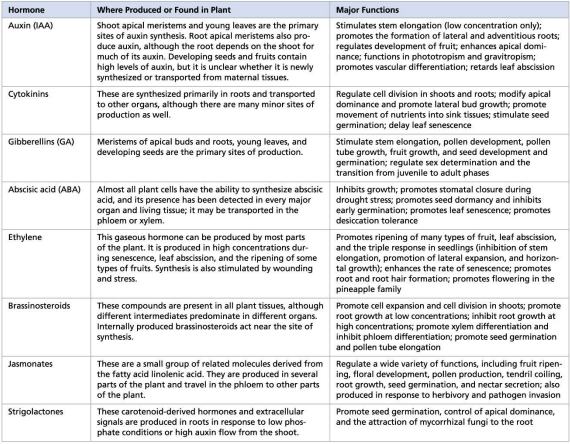
Separate note for this table, too.
Auxins
Tropism - It is any response resulting in curvature of organs toward or away from a stimulus.
Phototropism - It is the plant’s response to light.
(True) - In the late 1800s, Charles and Francis Darwin conducted experiments on phototropism. They observed that a grass seedling could bend toward light only if the coleoptile tip was present and exposed to light.
(True) - The Darwins theorized that a signal was transmitted from the tip to the elongating region; and in 1913, Peter Boysen-Jensen demonstrated that the signal was a mobile chemical substance.
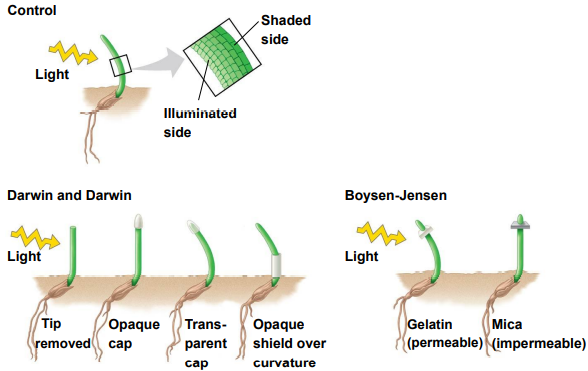
Auxin - Refers to any chemical that promotes elongation of coleoptiles.
Indoleacetic Acid (IAA) - It is a common auxin in plants. Our lecture refers to IAA when talking about auxins.
(True) - Transport of auxin is polar; it is produced in shoot tips and is transported down the stem--from north pole to south pole.
Auxin Transporter Proteins - These are proteins that move auxins from the basal end of one cell to the apical end of the neighboring cell.
(True) - The direction of auxin does not change in response to gravity.
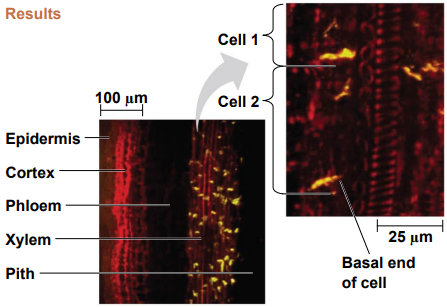
The Role of Auxin in Cell Elongation
(True) - According to the acid growth hypothesis, auxin stimulates proton pumps in the plasma membrane. Proton pumps move H+ into the cell, lowering pH levels in the cell wall, increasing membrane potential.
(True) - Reduced pH activates expansins.
Expansins - These are enzymes that loosen the fabric of the cell wall.
(True) - Osmotic uptake of water into the cell increases turgor pressure.
(True) - Increased cell wall plasticity plus increased turgor pressure enable the cell to elongate.
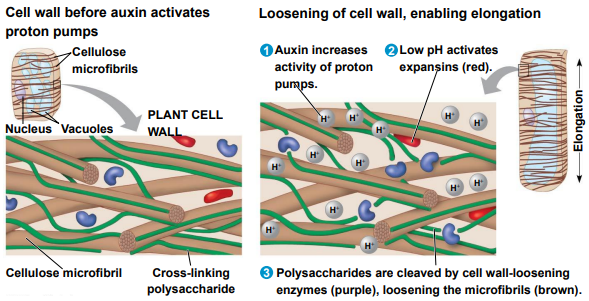
(True) - Auxin also alters gene expression and stimulates a sustained growth response.
Auxin’s Role in Plant Development
(True) - Polar transport of auxin plays a role in pattern formation of the developing plant. Reduced auxin flow rom the shoot of a branch stimulates growth in lower branches.
(True) - Auxin transport plays a role in phyllotaxy. Polar transport of auxin from leaf margins directs leaf venation pattern.
Phyllotaxy - The arrangements of leaves on the stem.
(True) - Auxin transport also controls the activity of the vascular cambium. Organization of female angiosperm gametophytes is likely regulated by an auxin gradient
Vascular Cambium - Its function is to initiate secondary growth at lateral meristems, which refers to the formation of branches.
Practical Uses for Auxins
Indolebutyric Acid (IBA) - It is an auxin that stimulates adventitious roots and is used in vegetative propagation of plants by cuttings.
Vegetative Propagation - An asexual reproduction in which plants reproduce from stems, roots, or leaves.
(True) - Synthetic auxins used in herbicides such as 2,4-D kill eudicots by causing a hormonal overdose; monocots are able to inactivate these hormones.
(True) - Developing seeds produce auxin, which promotes fruit development.
(True) - Greenhouse tomatoes produce few seeds. Spraying synthetic auxins on greenhouse tomatoes improves fruit development.
Cytokinins
(True) - Cytokinins are named such because they stimulate cytokinesis--cell division.
Control of Cell Division and Differentiation
(True) - Cytokinins are produced in actively growing tissues such as roots, embryos, and fruits.
(True) - Cytokinins work together with auxin to control cell division and differentiation.
Control of Apical Dominance
Apical Dominance - It is the terminal bud’s ability to suppress the development of axillary buds.
(True) - Apical dominance is under the control of sugar, cytokinins, auxin, and strigolactone.
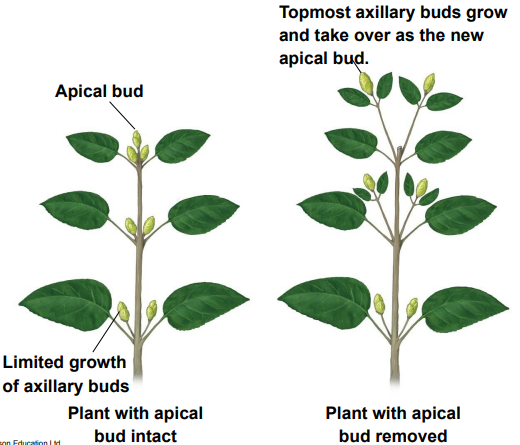
Anti-Aging Effects
(True) - Cytokinins slow the aging of some plant organs by inhibiting protein breakdown, stimulating RNA and protein synthesis, and mobilizing nutrients from surrounding tissues.
Gibberellins
Gibberellins - These hormones have a variety of effects, such as stem elongation, fruit growth, and seed germination.
Stem Elongation
(True) - Gibberellins are produced in young roots and leaves.
(True) - Gibberellins stimulate the growth of leaves and stems by enhancing cell elongation and cell division.
Bolting - It is the rapid growth of the floral stalk, which is induced by gibberellins.
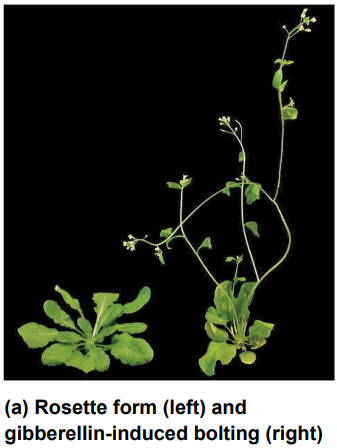
Fruit Growth
Auxin, Gibberellins - In many plants, these hormones must be present for fruit to develop.
(True) - Gibberellins are used in spraying of Thompson seedless grapes.
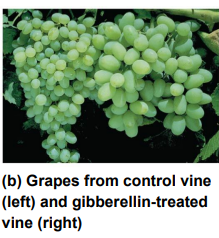
Germination
(True) - After water is imbibed, release of gibberellins from the embryo signals need to germinate.
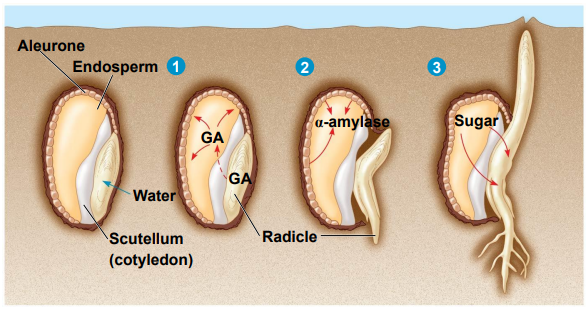
Abscisic Acid
Abscisic Acid (ABA) - This is the a hormone that slows growth, often by antagonizing the actions of growth hormones.
(True) aba HAS many other effects on plates, even including geeddermancy and defencing.
Seed Dormancy
(True) - ABA increases the likelihood that the seed will only growth they won’t need to germinate i ibta, in many dormant seeds need to be activated.
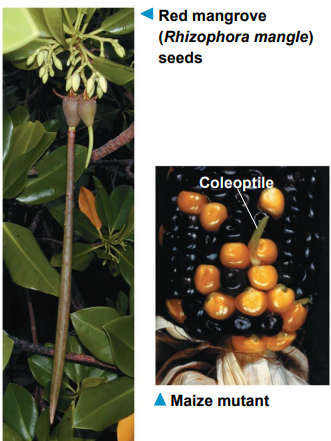
Drought Tolerance
(True) - ABA is the primary internal signal that enables plants to withstand drought.
(True) - ABA accumulation in wilting leaves cause stomata to close rapidly.
Early Warning System - The transport of ABA from water-stressed root systems to leaves can act as?
Ethylene
Ethylene - Plants produce this hormone in response to stresses, such as drought, flooding, mechanical pressure, injury, and infection.
(True) - The effects of ethylene include response to mechanical stress, senescence, leaf abscission, and fruit ripening.
The Triple Response to Mechanical Stress
(True) - Ethylene is produced when a seedling tip pushes against an obstacle.
Triple Response - Production of ethylene tiggers the following responses: slowed stem elongation, stem thickening, stem begins growing horizontally.
(True) - Vertical growth resumes when the effects of ethylene wear off.
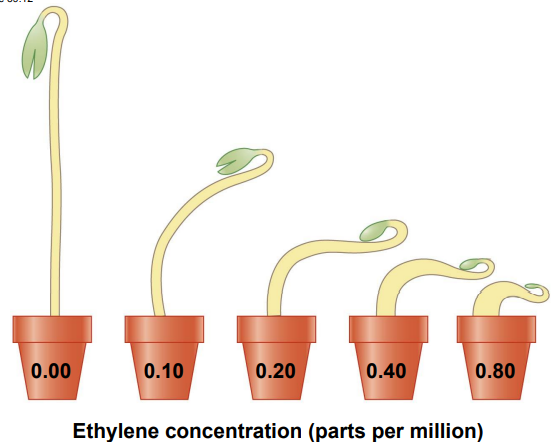
(True) - Some Arabidopsis mutants have abnormal triple responses.
Ethylene-Insensitive (ein) - These mutants fail to undergo the triple response after exposure to ethylene.
Ethylene-Overproducing (eto) - These mutants undergo the triple response even in the absence of obstacles.
Constitutive Triple-Response (ctr) - These mutants undergo a triple response even if ethylene isn’t present.
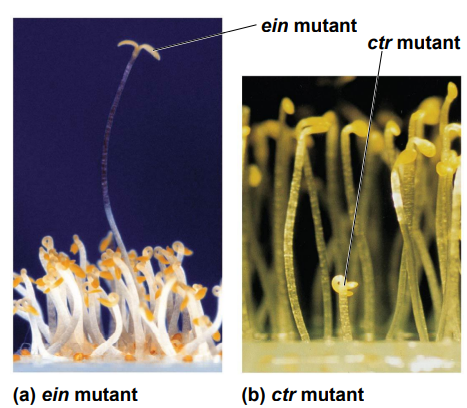
Senescence
Senescence - It is the programmed death of certain cells/organs/plants.
(True) - A burst of ethylene is associated with the onset of apoptosis.
Apoptosis - It is the process involved in programmed cell deaths.
Leaf Abscission
Leaf Abscission - It is the process that occurs in autumn when leaves fall. A change in the balance of auxin and ethylene controls it.
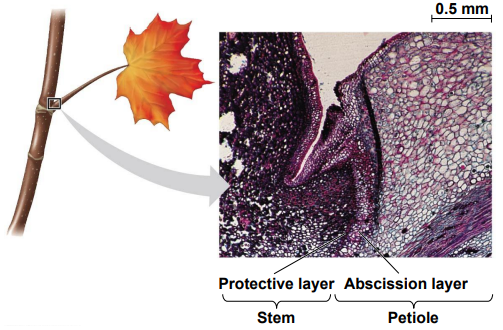
Fruit Ripening
(True) - In many cases, a burst of ethylene production in a fruit triggers the ripening process.
(True) - Ethylene triggers ripening and ripening triggers release of more ethylene.
(True) - Fruit producers can control ripening by picking green fruit and controlling ethylene levels.
More Recently Discovered Hormones: Brassinosteroids
Brassinosteroids - These hormones induce cell elongation and division in stem segments and seedlings at low concentration. They slow leaf abscission and promote xylem differentiation.
(True) - Brassinosteroids are chemically similar to cholesterol and the sex hormones of animals.
More Recently Discovered Hormones: Jasmonates
Jasmonates - These hormones are produced in response to wounding, and are involved in controlling plant defenses.
Jasmonate (JA), Methyl Jasmonate (MeJA) - Give the two types of Jasmonates that play important roles in plant defense and development.
(True) - Jasmonates also regulate many other physiological processes, including: nectar secretion, fruit ripening, pollen production, flowering time, seed germination, root growth, tuber formation, and Mycorrhizal Symbiosis
More Recently Discovered Hormones: Strigolactones
Strigolactones - These hormones are xylem-mobile chemicals that stimulate seed germination, suppress adventitious root formation, help establish mycorrhizal associations, and help control apical dominance.
Striga Parasitic Plants - Strigolactones are named after, what?
(True) - Striga seeds germinate when host plants to exude strigolactones through their roots.
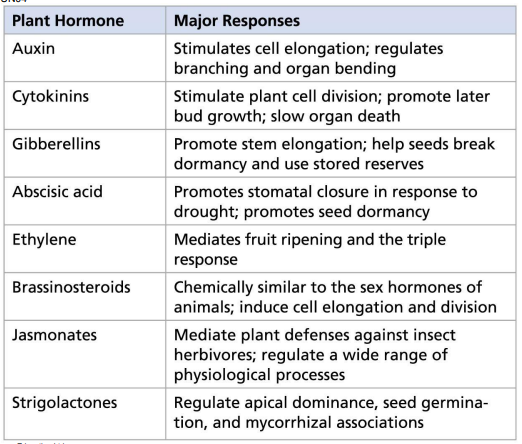
Concept 39.3: Responses to Light are Critical for Plant Success
(True) - Light cues many key events in plant growth and development.
Photomorphogenesis - What do you call the effects of light on plant morphology?
(True) - Plants detect not only the presence of light, but also its direction, intensity, and wavelength (color).
Action Spectrum - This is a graph that depicts the relative response of a process to different wavelengths of light.
(True) - Action spectra are useful in studying any process that depends on light.
(True) - Action spectra can also be used to determine which responses are mediated by a specific photoreceptor.
Blue-Light Photoreceptors, Phytochromes - What are the two major classes of light receptors.
Blue-Light Photoreceptors
Blue Light - It is a light receptor that initiates a variety of plant responses, such as hypocotyl elongation, stomatal opening, and phototropism.
Phototropin - It is a protein kinase involved in mediating plant responses to blue light.
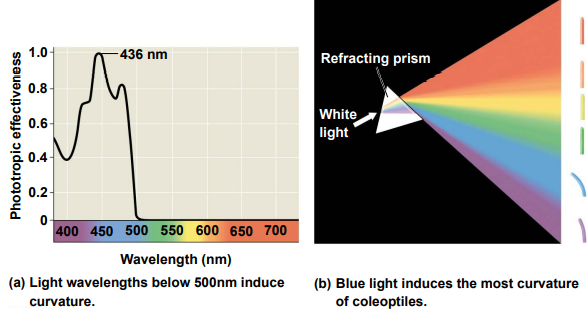
Phytochrome Photoreceptors
Phytochromes - These photoreceptors are pigments that regulate many of a plant’s responses to light throughout its life.
(True) - In addition to de-etiolation, phytochrome photoreceptors triggers seed germination and shade avoidance.
Phytochromes and Seed Germination
(True) - Many seeds remain dormant until light and other conditions are near optimal.
(True) - In the 1930s, scientists at the US Department of Agriculture determined the action spectrum for light-induced germination of lettuce seeds.
(True) - Red light increased germination, while far-red light inhibited germination.
(True) - The effects of red and far-red light are reversible; the final light exposure determines the response.
(True) - Phytochromes are the photoreceptors responsible for the opposing effects of red and far-red light.
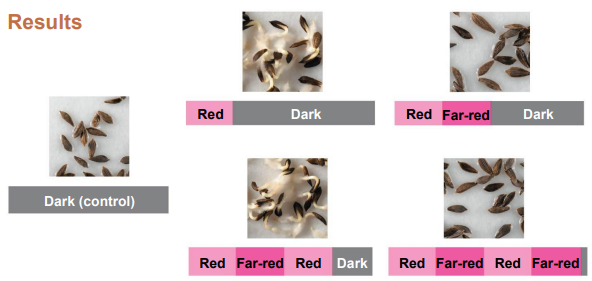
Pr, Pfr - Phytochromes exist in two photoreversible states, what are they?
(True) - The conversion of Pr to Pfr triggers many developmental responses.
Red Light - What triggers the conversion of Pr to Pfr?
Far-Red Light - What triggers the conversion of Pfr to Pr
(True) - The conversion of Pr to Pfr is faster than the reverse process.
(True) - Sunlight, containing both red and far-red light, increases the ratio of Pfr to Pr and triggers germination.
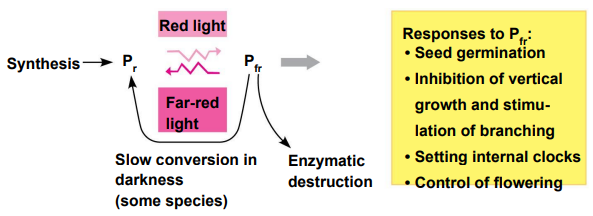
Phytochromes and Shade Avoidance
(True) - The phytochrome system also provides the plant with information about the quality of light.
(True) - Leaves in the canopy absorb red light and allows far-red light to pass through the shaded plants below.
“Shade Avoidance” Response - It is a response when a tree is shaded and the phytochrome ratio shifts in favor of Pr, inducing vertical growth.
Biological Clocks and Circadian Rhythms
(True) - Many plant processes oscillate during the day in response to light and temperature changes.
Oscillate/Oscillation - It is the process of repeating variations of any quantity or measure about its equilibrium value in time.
(True) - Many other processes oscillate with a frequency of 24 hours, even under constant environmental conditions. Example: Legumes lower their leaves in the evening and raise them in the morning--even when kept in constant light or darkness.
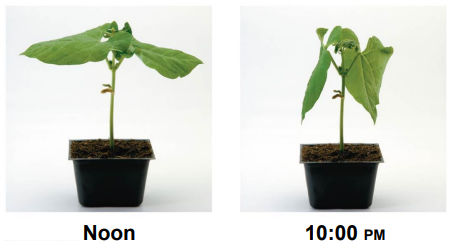
Circadian Rhythms - Cycles that are about 24 hours long and are governed by an internal “clock”.
(True) - Circadian Rhythms can be free-running, varying from 21 to 27 hours when organisms are kept in a constant environment.
(True) - The 24-hour period arises from the transcription of “clock genes” regulated through negative-feedback loops.
Effect of Light on the Biological Clock
(True) - Phytochrome conversion marks sunrise and sunset, providing the biological clock with environmental cues.
Photoperiodism and Responses to Seasons
Photoperiod - Refers to the relative lengths of night and day. It is the environmental stimulus plants use to detect the time of the year..
Photoperiodism - It is the physiological response to photoperiod.
Photoperiodism and Control of Flowering
(True) - Some processes, including flowering, require a certain photoperiod.
Short-Day Plants - These are plants that flower when a light period is shorter than a critical length.
Long-Day Plants - These are plants that flower when a light period is longer than a certain number of hours.
Day-Neutral Plants - These are plants whose flowering is controlled by plant maturity, not photoperiod.
Critical Night Length
(True) - In the 1940s, researchers discovered that flowering and other responses to photoperiod are actually controlled by night length, not day length.
Short-Day|Long-Night Plants - Flowering of these plants is governed by whether the critical night length sets a minimum number of dark hours.
Long-Day|Short-Night Plants - Flowering of these plants is governed by whether the critical night length sets a maximum number of dark hours.
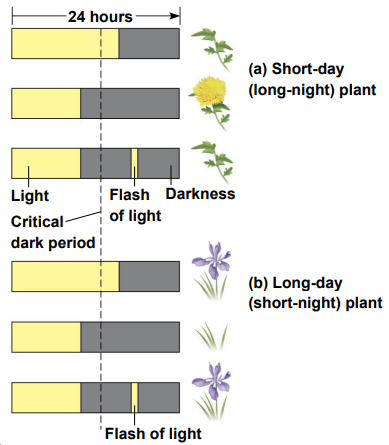
Red Light - What light color is most effective in interrupting the night length?
Phytochrome - It is the pigment that detects red light?
(True) - A flash or red light, followed by a flash of far-red light does not interrupt night length.
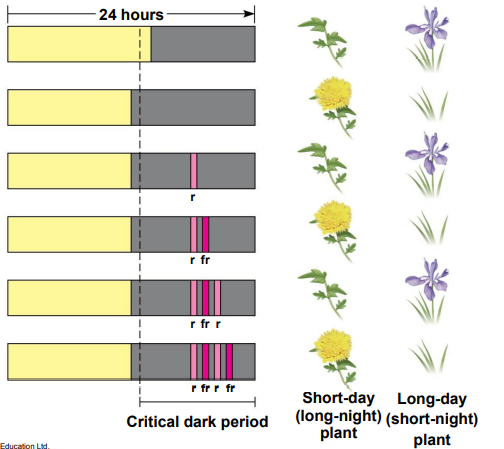
(True) - Some plants flower after only a single exposure to the required photoperiod. Whereas others will need several successful days.
(True) - Still, others need an environmental stimulus in addition to the required photoperiod. Example: Vernalization.
Vernalization - It is a pretreatment with cold to induce flowering.
A Flowering Hormone?
(True) - Photoperiod is detected by leaves, which cue buds to develop as flowers.
Florigen - It is the flowering signal molecule.
Flowering Locus T (FT) Gene - What gene protein governs the hormone, florigen?
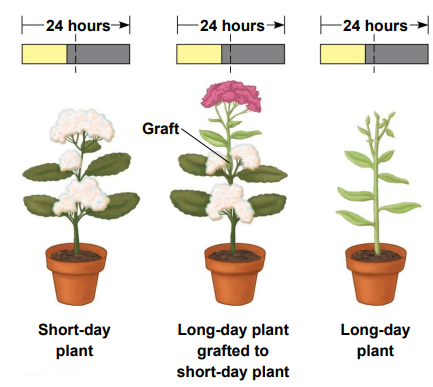
Concept 39.4: Plants Respond to a Wide Variety of Stimuli Other than Light
(True) - Because of immobility, plants must adjust to a range of environmental circumstances through developmental and physiological mechanisms.
Gravity
Gravitropism - It is the plant’s response to gravity.
(True) - Roots show positive gravitropism; shoots show negative gravitropism.
Statoliths - These are dense, cytoplasmic components and plants may detect gravity by the settling of these.
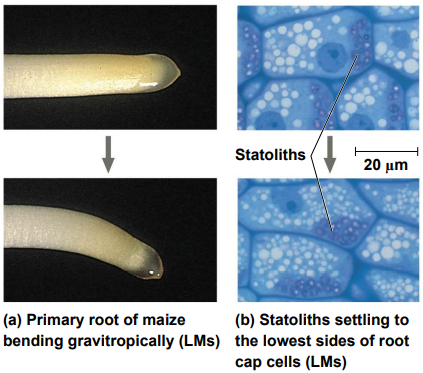
(True) - Some plants that lack statoliths are still capable of gravitropism. Example: Arabidopsis mutants.
(True) - Dense organelles and starch granules may contribute to gravity detection.
Mechanical Stimuli
Thigmomorphogenesis - It refers to plant form changes that result from mechanical disturbance.
(True) - An example of thigmomorphogenesis is when you rub the stems of young plants a couple of times daily, plants grow shorter than normal.
Thigmotropism - It is a plant’s growth in response to touch.
(True) - Thigmotropism occurs in vines and other climbing plants.
(True) - Some plants undergo rapid leaf movements in response to mechanical stimulation. Example: Mimosa pudica folds its leaflets and collapses in response to touch.
Action Potentials - The touch response of the mimosa pudica results from the transmission of?
Environmental Stresses
(True) - Environmental stresses have a potentially adverse effect on survival, growth, and reproduction.
Biotic (Living), Abiotic (Nonliving) - Plant stressants can be?
(True) - Biotic stresses include herbivores and pathogens.
(True) - Abiotic stresses include drought, flooding, salt stress, heat stress, and cold stress.
Drought
(True) - Plants may wilt or die when water loss by transpiration exceeds water absorption.
(True) - During drought, plants reduce transpiration by closing stomata, reducing exposed surface area, and in some species, shedding leaves.
Flooding
(True) - Waterlogged soil lacks the air spaces needed to provide oxygen for cellular respiration in roots.
(True) - Enzymatic destruction of root cortex cells creates air tubes that help plants survive oxygen deprivation during flooding.
(True) - Some plants such as mangroves also produce aerial roots.
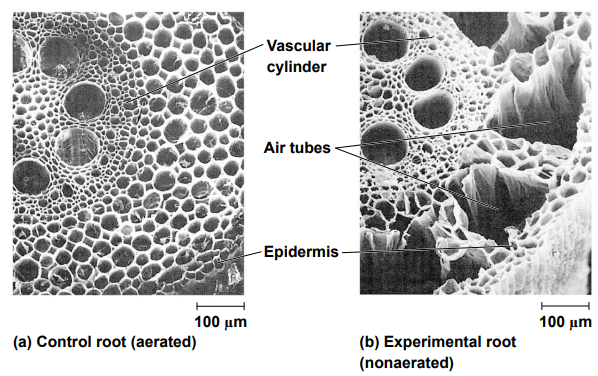
Salt Stress
(True) - Sodium and some other ions are toxic to plants in high concentrations.
(True) - Salt can lower water potential of the soil solution and reduce water uptake.
(True) - Plants respond to salt stress by producing solutes tolerated at high concentrations. This process keeps the water potential of cells more negative than that of the soil solution.
Heat Stress
(True) - Excessive heat can denature a plant’s enzymes. Transpiration helps cool leaves by evaporative cooling.
Heat-Shock Proteins - These proteins are produced at temperatures above 40 degrees to help protect other proteins from heat stress.
Cold Stress
(True) - Cold temperatures decrease membrane fluidity.
(True) - Altering lipid composition of membranes is a response to cold stress.
(True) - Ice formation during freezing reduces water potential outside the cell. Cells of many frost-tolerant species increase solute concentration of the cytoplasm to reduce water loss from the cell.
(True) - Plants and many other organisms have antifreeze proteins that hinder the formation of ice crystals.
(True) - Frost tolerance can be increased in some crop plants by engineering antifreeze genes into their genomes.
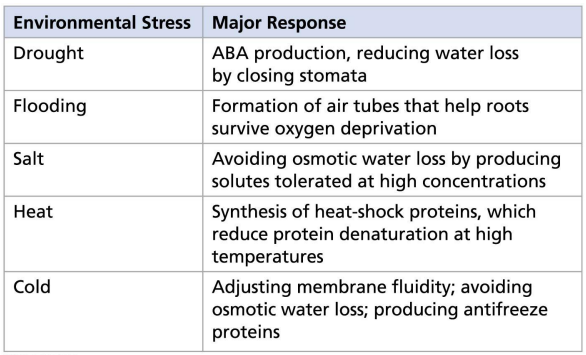
Concept 39.5: Plants Respond to Attacks by Pathogens and Herbivores
(True) - Plants use defense systems to deter herbivory, prevent infection, and combat pathogens.
Defenses Against Pathogens
(True) - A plant’s first line of defense against infection is the barrier presented by the epidermis and periderm.
Epidermis and Periderm - What are the plant’s first lines of defense against infection?
(True) - Pathogens can enter through wounds or natural openings, such as the stomata.
PAMP-Triggered Immunity and Effector-Triggered Immunity - What are the two types of immune responses when pathogens enter the plant?
PAMP-Triggered Immunity
Pathogen-Associated Molecular Patterns (PAMPs) - Plants must be able to recognize this, for the first line of immune defense depends on its recognition.
(True) - Molecular patterns are specific to certain pathogens.
(True) - PAMP recognition starts a chain of signalling events, leading to the production of antimicrobial chemicals and toughening of the cell wall.
Effector-Triggered Immunity
(True) - Plants and pathogens have engaged in an evolutionary arms race. Pathogens that’ve developed the ability to deliver effectors into plant cells can suppress PAMP-triggered immunity.
Effectors - These are pathogen-encoded proteins that cripple the host’s innate immune system.
(True) - A second level of plant immune defense evolved in response to these pathogens.
(True) - Effector-triggered immunity results from the action of hundreds of disease resistance (R) genes.
(True) - Each R protein is activated by a specific effector.
(True) - R proteins activate plant defenses by triggering signal transduction pathways. These defenses include hypersensitive response and systemic acquired resistance.
The Hypersensitive Response
Hypersensitive Response - It involves local cell and tissue death at and near the infected area.This response induces enzymes and chemicals that attack the pathogen.
(True) - The hypersensitive response also stimulates changes in the cell wall to confine the pathogen.
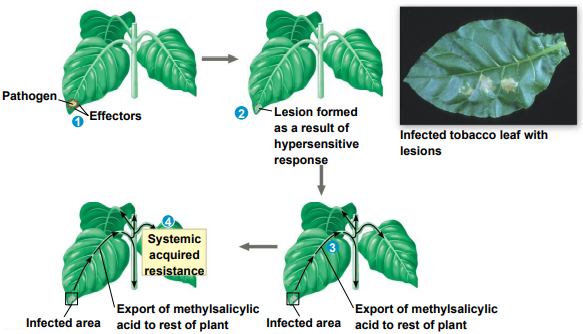
Systemic Acquired Resistance
Systemic Acquired Resistance - This resistance arises from the plant-wide expression of defense genes. It provides protection from a diversity of pathogens for several days.
(True) - Methylsalicylic acid is synthesized around the infection site and carried in the phloem to other remote sites where it is converted into salicylic acid.
(True) - Salicylic acid triggers the defense system to respond rapidly to another infection.
Defense Against Herbivores
Herbivory - These include plant-eating animals. This restricts plant growth because energy is diverted into defense.
(True) - Plants counter excessive herbivory with defenses that can be observed at multiple levels of biological organization.
Molecular, Cellular, Tissue, Organ, Organismal, Population, Community - Enumerate the levels of plant defenses against herbivores.
Molecular-Level Defenses - Chemical compounds including terpenoids, phenolics, and alkaloids can be produced to deter attackers.
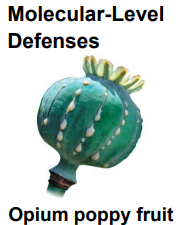
Cellular-Level Defenses - Cells may be specialized to form trichomes, store chemical deterrents, or produce irritants.
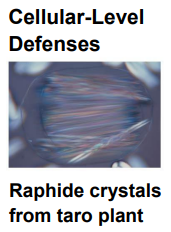
Tissue-Level Defenses - Leaves may be toughened with sclerenchyma tissue.
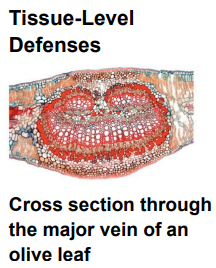
Organ-Level Defenses - Leaves can be modified into spines and bristles. Some species have leaves that appear partially eaten; others have structures that mimic insect eggs.
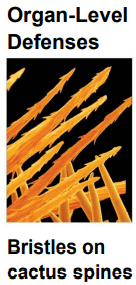
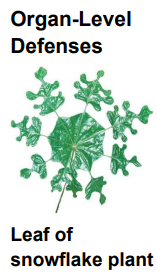
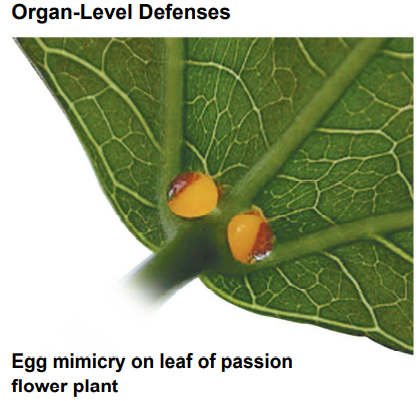
Organismal-Level Defenses - Plants may alter their physiology in response to attack by herbivores.
Example: - Tobacco plants alter their flowering time from night to morning in response to feeding by hawk-moth larvae.
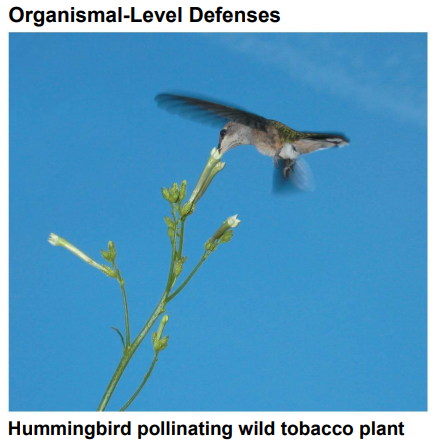
Population-Level Defenses - Some plants release chemicals in response to herbivore attacks that trigger defense responses in nearby members of the population.
Example: - Some plant populations use masting-- the synchronous mass seed production following long intervals to ensure some seeds survive herbivory.
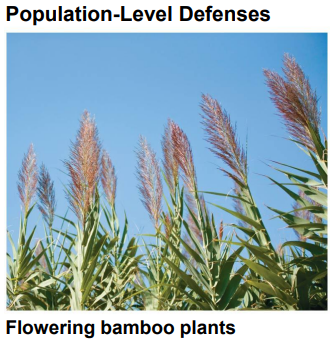
Community-Level Defenses - Some plants “recruit” predatory animals that help defend against specific herbivores.
